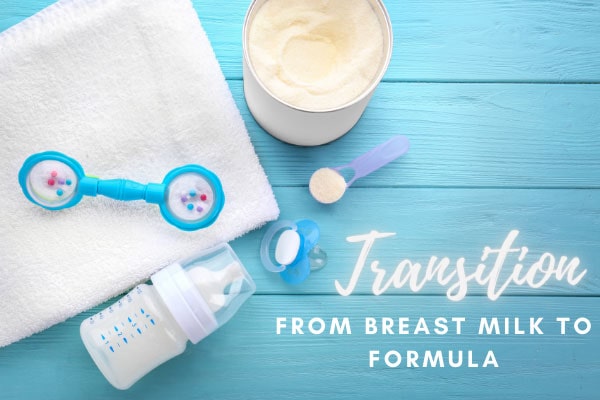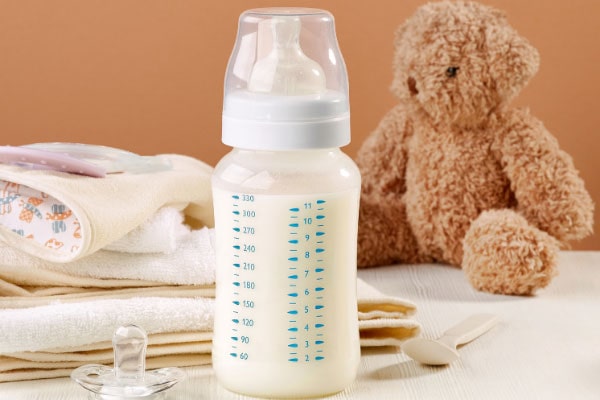Are you considering a transition from breastmilk to formula milk for your baby? This article will give you an extensive and step-by-step guide to approach this process. You will get to know the various reasons for switching a baby from breast milk to formula milk and the appropriate time to start this change.
This article also covers the essential preparations you need to make before making the transition. Moreover, switching a baby from breast milk to formula milk according to age is discussed. The impact of breastfeeding cessation on the mother is also mentioned.

Breastfeeding facilitates an intimate bond between child and mother. It is the first-ever food for the baby and is a highly nourishing diet for the baby. However, as the baby grows, the baby’s needs and responsibilities change. You have to consider switching from breast milk to formula milk. If that is the case with you, I got you covered here.
Why do mothers want to switch from breast milk to formula milk?
There are various reasons a mother considers to complete or partial transition from breastmilk to formula milk.
- You are going back to work, and you can’t pump at work. Thus, you want to do partial transition, where you breastfeed your baby when present and formula feed otherwise.
- Your milk supply is not fulfilling your baby’s hunger, and you feel the need to supplement with formula milk.
- Your baby is not gaining enough weight, has lower diaper output, and the pediatrician suggested supplementation.
- You have a medical condition and are taking medication that makes breastmilk unsafe for the baby.
- You got pregnant again and cannot or don’t want to continue breastfeeding.
- Your baby has a medical issue that makes it difficult for him to latch on or feed properly, i.e., tongue tie or lip tie.
- You have a timeline in your mind that you will stop breastfeeding at a specific age. You will stop breastfeeding, i.e., before teething or the first birthday of your baby. You are switching to the formula to achieve your goal.
- Your baby is self-weaning or losing interest in breastfeeding, and you need to provide him complete nutrition.
- Or simply, you want to stop breastfeeding and start formula. After all, it is your life, and you don’t need an excuse to do whatever you want unless it is in your child’s best interest and yourself.
These are just a few reasons to mention. Many women who want to breastfeed consider weaning, and many women who don’t want to breastfeed continue nursing. It is because of societal pressure, stereotypes, stigmatization, and norms.
I am a big advocate of your body, your choice. So, either you want to wean from breast milk early or continue nursing until 3 years. I support your decision if this is what you want, and it makes you happy. I believe is fed is best, either it is breastmilk or formula milk.
When is it appropriate to make the transition from breastmilk to formula milk?
There is no right time. Yes, this is true. Every mother has different struggles, and every baby has different needs. According to the World Health Organization, a baby should be exclusively breastfed (EBF) for 6 months. Nursing can be continued for 2 years and beyond.
American Academy of Pediatrics and the American Academy of Family Practice suggest the same duration for EBF and recommend to continue nursing for 1 year or until mother and child desire. American College of Obstetrics and Gynecology mentioned the same period of EBF and continued nursing as long as possible or desired (Lawrence & Lawrence, 2016).
However, as I mentioned above, you need to switch from breast milk to formula when you consider it necessary for you and your baby, whether at four months or two years. I cannot tell you the right time to start the transition, but I can tell you when it is not right to initiate the change. It is when you and your baby are not ready for this change. Various things in your life can make this transition more difficult for you and the baby. Following are a few things that can make this change more challenging.
- If your baby is going through a difficult phase like teething or is not feeling well, i.e., seasonal infections or any other medical condition.
- If you personally are going through a difficult phase like having marital difficulties, emotional problems, or otherwise at a difficult stage in your life.
- If your family is dealing with problems like a bereavement of a loved one, shifting, abandonment, any big family gathering like a wedding or a holiday.
These are some factors that can make this change stressful for you and your baby. If you want this process comfortable for both of you, try to choose when there is less likely to be any disruptions and interferences in your daily schedule. This is all I can suggest to you. The transition will not be smooth for both of you, so the least you can do is make things easy around you.
Preparations you need to do before switching from breast milk to formula milk
It would be best to consider various factors before starting to work on the transition stated below.
1. Selection of the transition process: partial, gradual or cold-turkey
Selection of the transition plan for switching from breastmilk to formula milk is necessary. It will provide a basis for other logistics. You can choose partial transition, gradual and complete transition and cold-turkey, and full change.
Partial
Partial transition is suitable when you want to continue breastfeeding and supplement nursing with formula milk. This is usually needed when the mother cannot pump and breastfeed only when she is at home, like in the mornings or evenings. It is also advisable when the milk supply is low and the baby is not gaining enough weight.
Gradual
Complete transition opted when the baby grows older, or the mother wants to discontinue breastfeeding. The gradual change is ideal in this situation. Substituting one nursing session with the formula milk and gradually increasing the bottle intake until your baby completely weans off breastmilk.
Cold-Turkey
In some situations, the abrupt discontinuation of breastfeeding is necessary, i.e., when the mother is away because of medical or personal reasons, she has to start a medication or therapy immediately. In some cases, the baby is in a medical emergency where he cannot be breastfed. In such situations, a sudden transition is made. Still, it is not recommended as this is stressful for both mother and the baby.
2. Introduce a supplementary device
Various devices are available in the market that can be used to feed the supplementary milk to your baby. These include at-breast supplementers, bottles, finger-feeders, cups, eyedroppers, medicine droppers, and syringes. Each device has its own advantages and disadvantages. The device’s efficiency depends on the parent’s proficiency, the device’s feasibility, and the baby’s needs.
The devices like at-breast supplementers, finger-feeders, and droppers are usually used when the supplementation is temporary because of the low milk supply or other conditions. These devices are difficult to use, are expensive, and require a lot of effort in cleaning. The most widely used supplementation device is a bottle or cups.
Cups may be tricky to use if you are supplementing at an early age and can lead to spills in small babies of a few months. Bottles, however, are easy and convenient to use and are socially more acceptable. In selecting a bottle, you need to consider the transition process you are opting for. You also need to think through the issues of nipple confusion and flow preferences.
Nipple confusion
If you are looking for a partial transition, nipple confusion can be a problem because the baby gets used to the bottle nipple or teat and may reject the breast totally. This usually occurs in the newborns where they got little chance to get imprint on the breastfeeding. If you start a bottle now, it is best to consider a nipple whose shape is identical to the breast nipple. Usually, wide-mouth nipples are recommended by the specialists because it mimics the shape of mother’s breast.
Flow preference
Breastmilk ejection occurs in spurts as per the baby’s demand while the flow of the bottle is steady and never stops until it is finished. Some babies may prefer the slow flow and reject bottle, while others prefer the fast flow of bottles and don’t like breastfeeding after that. It is advisable to select a nipple according to your baby’s preference and the supplementation plan you are adopting in such cases.
If you want a complete transition, the baby’s inclination towards the bottle because of the steady flow will be a pro for you. However, providing that you are going for partial switching, in that case, choice of bottle flow will be an issue. Select the best-suited teat according to your needs and baby’s preferences.
When to introduce bottle?
It is best to start expressed or pumped breastmilk in a bottle before ample time as you want to wean off breastmilk. This is because your baby will get used to bottle-feeding before the introduction of formula milk. It is not advisable to start the bottle before the baby is for 4 weeks. As, this will lead to nipple confusion, breast rejection, or a nursing strike.
3. Selection of the formula milk
The infant formulas are an adequate substitute for breastmilk. They are designed and intended to mimics the nutritional composition of breast milk. The manufacture and production of infant formula are regulated by the Food and Drug Administration to meet the national and international quality criteria.
Formula milk is available in three forms: powdered, concentrated liquid, and ready-to-feed formulas. Powdered formula is the least expensive form and is widely used by parents around the world.
The main classes of infant formula are cow-milk based formula, soy-based formula, and specialized formula.
- Cow milk is the basis of various infant formulas as it contains a high content of fat, minerals, and proteins. Cow-milk-based formulas contain vegetable oils, vitamins, minerals, and iron.
- Soy-based formulas are considered the best option for children with galactosemia or congenital lactase deficiency. This formula helps with colic and milk allergies. However, it is recommended not to use soy-based milk in infants less than six months old.
- Specialized or hypoallergenic formulas are used for children with cow milk and spy milk allergies. These formulas are hydrolyzed and made suitable for infants with protein allergies.
- Amino acid formulas are also used for children who show reactions towards hypoallergenic formulas.
- Non-bovine milk resources are also used in making formulas for children and infants allergic to cow milk. These milk formulas use milk resources from goat, ewe, mare, donkey, or camel. Formulas based on chicken and lamb are also available.
Suppose you have food allergies in the family. In that case, it is best to get your baby tested for allergies and consult your pediatrician for a suitable formula for your child (Martin, Ling, & Blackburn, 2016).
Some important point for breastmilk substitution
- For babies under 12 months, iron-fortified infant formula is recommended.
- For babies between 12 to 18 months of age, follow-up formula or whole 3.25% milk is suitable.
- From 18 to 24 months age, babies can take whole milk.
- Babies older than 2 years can intake whole or 2% milk.
Preparing and heating formula milk
Mothers who exclusively breastfeed their children find it challenging to get used to formula feeding. Breastmilk is always ready to use. You don’t need to heat the water, prepare the milk, and afterward wash and sterilize the bottles. Mothers may need some time to get habituated to bottle feeding. The key points that mothers should consider are the following:
- Careful understanding of the water and powder ratio
- Using lukewarm water to prepare formula
- Mixing the formula properly to avoid lumps
- Reheating the formula in a bottle warmer and not in the microwave
- Not using the milk sitting at room temperature for more than an hour. You should discard old and stale milk.
- Sterilize bottles regularly
How much supplementation is needed initially?
Figuring out the right proportion and balance while supplementing is critical. Especially if you are considering partial weaning, the over-feeding of the formula can under-stimulate your milk production. You should consult your pediatrician and can make a chart as per your child’s nutritional needs.

Have you already stopped breastfeeding, but your child is feeding on pumped and stored milk? You can always freeze breast milk for later use. Just make sure you have an adequate stash before ceasing the pumping sessions. If your child transitions too slowly, you will run out of the reserved milk. This will be chaotic. Having enough storage is necessary for a smooth transition.
Once you worked out the logistics, it’s time to begin the transition.
Tips for switching from breastmilk according to the child age
Transitioning for 3 to 6 months’ baby
Transitioning a baby less than 6 months old requires a little extra work because he is not on the semi-solid or solid diet until 5 months and exclusively breastfeeds. In this situation, you need to replace the nursing sessions with formula milk gradually. If your baby rejects the formula initially, you need to try out various formulas before finding the one that your baby likes.
You can also combine formula milk and breast milk, increasing the ratio of formula milk gradually. This will also develop your baby’s taste for the formula.
For such younger babies, you can involve the father and other caregivers in the feeding time. Because if you provide the bottle to the baby, he may get distracted by your presence and reject the bottle.
Transitioning for 6 to 12 months old baby
If you plan on the transition from 6 months of age, your baby will indeed be started semi-solid food by now. So, if you have solid food in your baby’s diet, you can supplement the mid-day feeding sessions with a snack or cereal. This way, you don’t have to rely much on formula milk, and your baby will focus on other food groups.
At this age, you may find it challenging to switch the nighttime nursing sessions with formula milk as babies prefer to suckle on familiar breast nipples. However, take it slow, and you will eventually be there.
Transitioning for 12 months and older babies
The transition will be less complicated when your baby has passed its first birthday. At this age, the baby is more active and gets involved in various activities and plays.
You can offer him a snack before the nursing session and offer him food when the family sits together for meals. This way, it will be easy to transition from breastmilk to formula.
Baby-led weaning
Baby-led weaning means not refusing the breast when asked but also not offering the breast when not interested. In some cases, the babies lose interest in breastfeeding and prefer to have a bottle and other food. This usually happens in older children or when the milk supply is low. This is called baby-led weaning and is totally natural in older children.
It is not worrisome if your baby is getting enough nutrition from other resources. However, if your baby is younger, you need to consider the factors causing the rejection and work on the issues with a lactation expert or pediatrician.
General tips for transition from breast milk to formula
According to the article ‘Weaning your child from breastfeeding’ published in the journal ‘Pediatrics and Child Health’ following things should consider during the transition and weaning process.
- The most manageable switch for you and your baby is a gradual transition over several weeks, months, or even longer. Cold-turkey, sudden, and abrupt weaning is harsh for both of you.
- The professionals also suggested that using a cup instead of a bottle to introduce the formula increases the likelihood of accepting the formula and makes the transition easier. Babies can quickly learn to drink from sippy cups at six months.
- Start gradually by substituting one nursing session at a time. This nursing session could be the least interesting for the baby, i.e., mid-morning session when he is busy playing. Or it can be the most bothersome session for you, i.e., early in the morning. You can ask your partner to prepare and feed formula to your baby and have some extra sleepy time.
- After the first substitution is engrained in the baby’s routine, try to substitute the second feeding at the opposite time of the day. This way, the baby will not associate formula feeding with a specific time of the day.
- The pace of transition and weaning is up to you and your baby; however, the slower, the better. Give at least a few days to weeks for each substitute feeding session until your baby gets habituated.
- Regularly check your baby’s weight and diaper output. Change in the poop color and consistency is regular. However, if you feel anything unusual, i.e., the poop is too hard, or your baby is having a hard time pooping, this can indicate constipation. Immediately consult your pediatrician.
- If your baby is rejecting the formula, don’t starve him into submission. Try to give him formula during his sleep time, make the feeding time distraction-free, and ask other caregivers to feed the baby with the bottle.
- You may have to try various bottles and teats before finding the right one. Don’t frustrate; this will only worsen the process. Get as much social support as you want. Your baby will eventually stop breastfeeding, so don’t rush it.
- Wait to give formula until your baby is hungry. However, don’t wait too long, or the baby will become angry and will not take the formula bottle. It is a motherly instinct to understand when exactly you need to feed the baby.
- Make the right amount of formula, too little, and he will be not satiated. Too much formula leads to overfeeding, which can cause spit-ups and later obesity in children.
- During the transition, you may feel an uncomfortable sensation or pain in your breasts. Try to express just the amount of milk that relieves the pressure. Your body will soon get the message that there is no need to make more milk, and your supply will be diminished. You can use medication like ibuprofen for the pain. You can also apply cold compressions and gel packs to relieve uneasiness.
- During the weaning process, check your breasts regularly for any blocked ducts, firm, or tender areas in your breast. If you experience any such issue, you need to consult your lactation consultant.
You can push the pause button.
There can be setbacks and regression periods during the transition. Your baby will totally reject the formula after having the successful substitution sessions. He may not be okay, having physical problems like teething or earache, or maybe because he is just a baby. You will feel frustrated and angered because it feels like you lost all the progress. But remember, your efforts never go in vain.
Once your baby gets well, you can start over, or your baby may start the process from where he left it. Just be comfortable, kind, and gentle towards yourself and your baby.
Impact of discontinuing breastfeeding on mothers
During breastfeeding, a mother’s body is secreting the hormone prolactin in high quantity. Prolactin suppresses the levels of estrogen and progesterone hormone. However, when the breastfeeding stops, prolactin level decreases, leading to an increase in estrogen and progesterone.
The hormonal shift leads to sadness and depression. Weaning from breastmilk can also lead to a sense of loss of intimacy with the baby in mothers. Some mothers consider this an end to a beautiful and lovely stage and feel themselves replaceable (Dalfen, 2010).
You can always increase the intimate time with your baby outside of the need for food. As he becomes older, he will interact more. You can play various games with them and spend some quality time together. This will beat the blues out of you, and you will be happy with your decision.




